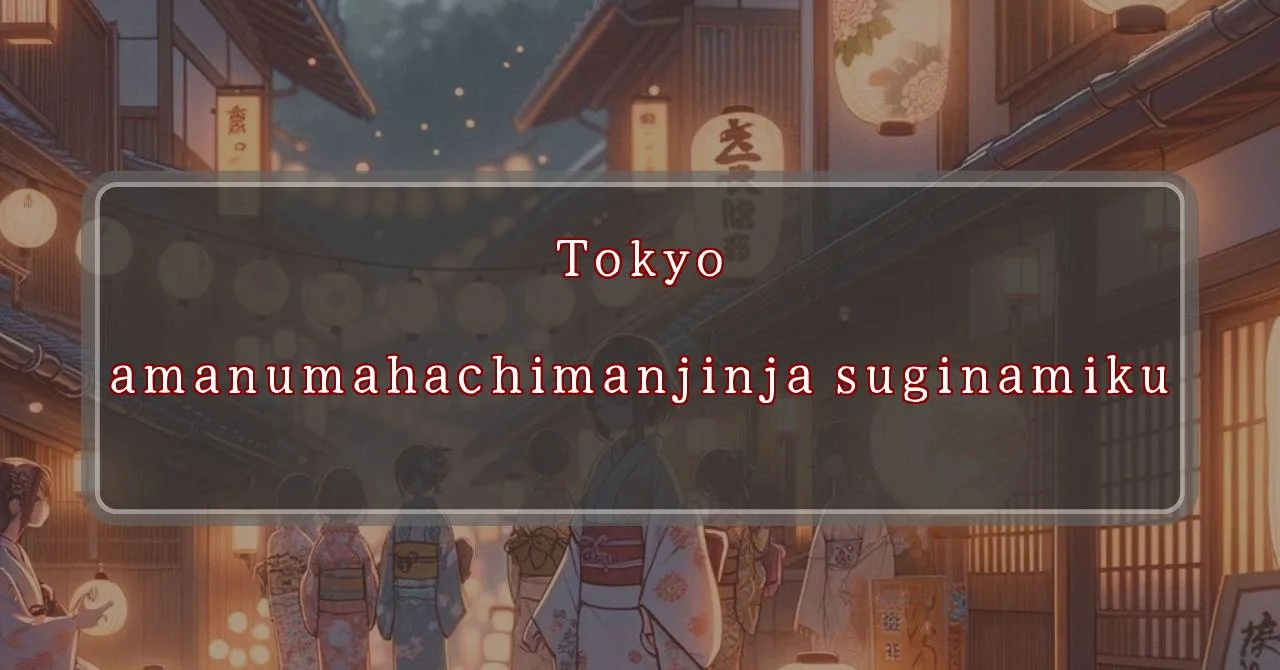A divine festival of lights and music in Tokyo
Basic Information
A grand festival held annually at Tenma Hachiman Shrine in Suginami Ward, Tokyo, known for its vibrant atmosphere and rich cultural traditions.
- Address: 2-18-5 Amanuma, Suginami-ku, Tokyo 167-0032
- Phone Number: 03-3398-2514
- Access: A 6-minute walk north from Ogikubo Station on the Tokyo Metro Marunouchi Line or JR Chuo/Sobu Line.
- Festival Days: August 25th (Fri) and 26th (Sat), 2024
Main Events and Attractions of the Festival
The Tenma Hachiman Shrine Festival is a vibrant and lively event that offers a variety of attractions and activities for visitors of all ages.
Children’s Mikoshi Parade
On the first day of the festival, children from the local community gather at the shrine to participate in a parade carrying portable mikoshi shrines. This colorful and energetic procession is a highlight of the festival, and it’s a great opportunity to see the children’s excitement and enthusiasm.
Dedication of Performing Arts
On the evening of the first day, a dedication of performing arts takes place at the shrine’s kagura殿 (ritual dance hall). This event features traditional Japanese performing arts such as kagura (sacred Shinto dance) and浦安の舞 (Urayasu no Mai, a ceremonial dance for good fortune). These performances are a beautiful and captivating way to experience Japanese culture.
Mikoshi Procession and Grand Festival
The main event of the festival takes place on the second day. In the morning, a mikoshi procession winds its way through the streets of the neighborhood, accompanied by music and dancing. The procession is a lively and festive sight, and it’s a great opportunity to see the community come together to celebrate.
In the afternoon, the grand festival is held at the shrine. This event includes a variety of activities, such as kagura performances, sumo wrestling matches, and food stalls. It’s a great opportunity to experience the lively atmosphere of a traditional Japanese festival.
酉の市 (酉の市)
In November, the Tenma Hachiman Shrine also holds a酉の市 (酉の市), or “酉の市.” This market is dedicated to the god of wealth and good fortune, and it’s a popular place to buy縁起物 (engimono), or good luck charms. The market is also known for its lively atmosphere and its delicious street food.
Blessings and Deities
Tenma Hachiman Shrine is dedicated to the god Hachiman, who is revered as the deity of warriors, victory, and archery. Hachiman is also associated with agriculture, commerce, and prosperity. The shrine also enshrines the goddess Ichikishimahime, who is associated with water, fertility, and safe childbirth.
- Hachiman: God of warriors, victory, archery, agriculture, commerce, and prosperity
- Ichikishimahime: Goddess of water, fertility, and safe childbirth
Origin and History
The origins of Tenma Hachiman Shrine are unclear, but it is believed to have been founded during the Kamakura period (1185-1333). The shrine was originally located in a different part of Suginami Ward, but it was moved to its current location in 1671. The shrine has been rebuilt and renovated several times over the centuries, most recently in 1986.
- Founded: Kamakura period (1185-1333)
- Moved to current location: 1671
- Rebuilt and renovated: Several times over the centuries, most recently in 1986
Tips and Notes for Visitors
Here are some tips and notes for visitors to Tenma Hachiman Shrine:
- The shrine is open daily from 9:00 AM to 5:00 PM.
- Admission is free.
- The shrine is a popular destination for weddings and other ceremonies, so it is best to avoid visiting during these times if you are looking for a quiet experience.
- There is a small parking lot available for visitors.
- The shrine is located in a residential area, so please be respectful of the neighbors.
Parking Information
There is a small parking lot available for visitors to Tenma Hachiman Shrine. The parking lot is located behind the shrine, and it can accommodate about 20 cars. The parking fee is 300 yen per day.
Popular Stalls and Food Carts in Recent Years
| Type of Stall | Description |
|---|---|
| Takoyaki | A staple at Japanese festivals. Characterized by a crispy outside and a creamy inside. |
| Jaga Butter | A simple yet popular snack of hot potatoes lavishly topped with melted butter. |
| Baby Castella | Small castella cakes, sweet and fluffy treats enjoyed by children and adults alike. |
| Grilled Ayu with Salt | Fresh ayu fish grilled whole with salt, a savory taste of Japanese summer. |
| Shaapin | A unique gourmet item influenced by foreign cuisine, with a chewy skin wrapping the filling. |
| Okonomiyaki | A Japanese grilled dish where you often choose your own ingredients for a personalized flavor. |
| Cotton Candy | A fluffy, sweet snack that’s extremely popular with children. |
| Chocolate Banana | A banana coated in chocolate, a fun and visually appealing dessert. |
| Kushiyaki | Various types of ingredients skewered and grilled, an easy-to-enjoy snack. |
| Yakisoba | Fried noodles mixed with a special sauce, a fast food favorite in Japan. |



